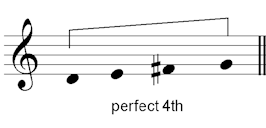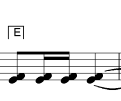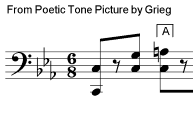So far, we have only learned about intervals between the tonic (lower noter in the interval) and another note in the major or minor scale built on that note.
In this lesson, we will learn to identify and write intervals between any two notes of the scale, in any of the keys up to 5 flats/sharps).
In other words, the lowest note might not be the tonic of the key – it could be any note from the scale.
First a little recap:
We previously learned that the intervals built above the tonic of a major scale are only perfect or major:
1- perfect unison
2- major 2nd
3- major 3rd
4- perfect 4th
5- perfect 5th
6- major 6th
7- major 7th
8- perfect 8ve (octave)
For example, here are the intervals built above the tonic G, in the G major scale:

So to find the interval quality between any two notes, use the lower note and make it into the tonic of a major scale.
- Write out the scale if you can’t do it in your head. Use the pattern TTS TTTS (tone/whole step = T and semitone/half step = S),
- Make sure that you use each letter of the musical alphabet (A-G) only once, apart from the first and last notes.
If the upper note is in the major scale formed by the lower note, the interval will be major (2nd, 3rd, 6th or 7th) or perfect (unison, 4th, 5th, octave).
If the upper note is not in the major scale formed by the lower, then the interval cannot be major or perfect. Instead, it will be minor, augmented or diminished.
Minor intervals are one semitone narrower than major intervals. For example, compare these intervals above the note G with those found in the G major scale (above):

Augmented intervals are one semitone wider than major or perfect intervals. Compare these intervals with those found in the G major scale:

Diminished intervals are one semitone narrower than minor or perfect intervals:

So, let’s say we need to work out this interval:

The key is A major (or perhaps F# minor, it doesn’t actually matter!), so the two notes we are looking at are D natural and G sharp.
The lower note is D, so to work out the interval, we first need to work out the D major scale. We don’t need to work out the whole thing, we just need to work it out as far as the 4th note. The 4th note in the D major scale is G natural, which would be a perfect 4th.

Now we need to compare the note in the question, and work out whether the interval is wider or narrower than a perfect 4th. G# is a semitone higher than G, so the interval has become wider. This means the interval must be an augmented 4th (because augmented intervals are one semitone wider than perfect intervals).
If it’s difficult to make a major scale from the lower note (for example, if it is A# or F##), you can start by working out the scale from the natural form of the note.
In this example, the lower note is F#.

F# major has 6 sharps in it, so it’s quite complicated, but F major has just one flat, so we can use that scale instead:

F natural to Bb is a perfect 4th. In the question, the interval is F# to Bb, so the interval has become narrower, because the lower note has been raised by a semitone. The interval is, therefore, a diminished 4th (because diminished intervals are one semitone narrower than perfect intervals).
Writing Intervals
Use the same method to write intervals. Let’s imagine you are asked to write a harmonic interval of a diminished 7th above this note:

Start by working out what letter name is needed, by counting out 7 letter names. F-G-A-B-C-D-E. Write in an E (without any accidentals).

Next, work out the major scale from the lower note. We will use the scale of F major instead of F# major: F-G-A-Bb-C-D-E-F.
We can see that E exists in the F major scale, so F-E is a major 7th. If the lower note is F#, then the interval is one semitone (half step) smaller, so the interval we have written so far (F#-E) must be a minor 7th.
We need to write a diminished 7th, which is one semitone (half step) smaller than a minor 7th. This means we need to make our interval smaller by one semitone. We do this by changing E natural to Eb.

Intervals Exercises
Hover your mouse over the questions (tap on mobiles) to reveal the answers.
1. Describe fully (e.g. major 2nd, perfect 8ve) these melodic intervals:




2. Describe fully (e.g. major 2nd, perfect 8ve) these harmonic intervals



























